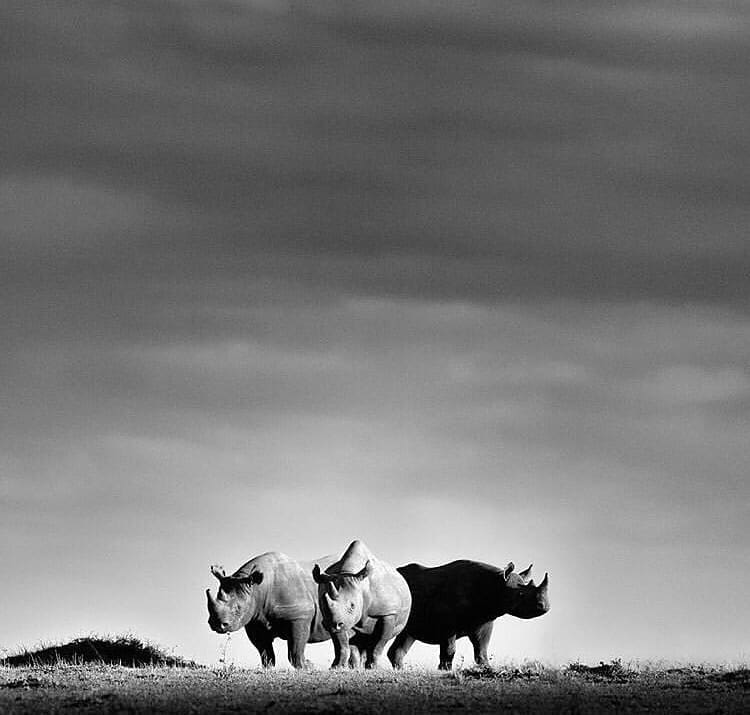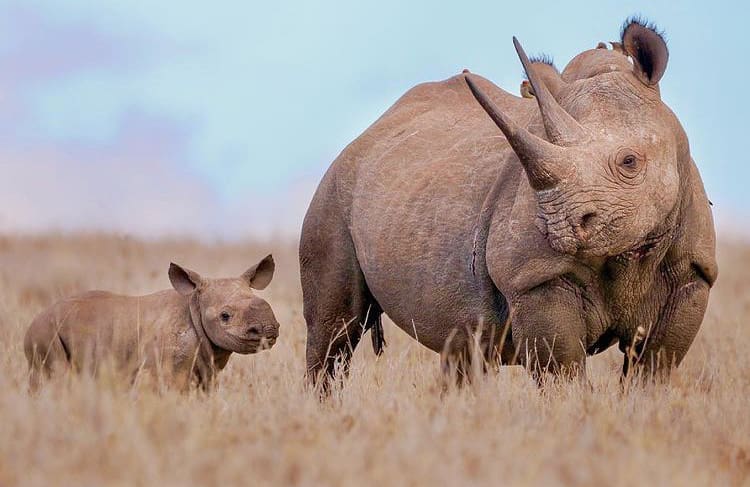[social_warfare]
The word rhinoceros is derived from Greek, and is a combination of two words – rhino (nose) and ceros (horn).
The black rhino is perfectly personified by this name as their smaller size makes their majestic horns seem even more pronounced.
What is the Black Rhino?
The black rhino is also known as the hooked-lip rhinoceros, and is one of two African rhino species. They are a member of the Big Five Animals of Africa, and have a fierce reputation among hunters and game rangers.

There are four subspecies of the black rhino. These are the; Southern Central black rhino, Eastern black rhino, South Western black rhino and the Western black rhino. Although the Western subspecies was officially declared extinct in 2011.
White Rhino vs Black Rhino
The black rhino is the smaller cousin of the white rhino. To most it is quite hard to tell the difference, but with a few small check points it becomes quite easy to distinguish the difference.
The most notable differences are their size, head size and lip shape – not their skin colour.
So why is it called the black rhino?
The exact origin of the name is unknown but it was thought to have come about as a means of distinction from the white rhino. The white rhino got its name from the word ‘wijd’, which means wide in Dutch, and refers to the species’ flat upper lip.
Appearance
How big is the Black Rhino?
The black rhino is the smallest of the African rhinos, but is still quite large in comparison with most other mammals on the continent. They are thick and stocky, and are move with a menacing demeanour. Male (bull) and female (cow) black rhinos grow to the same height – around 5.3ft (1.6m) on average, and approximately 11.5ft (3.5m) long from head to tail.
Males are more solidly built than females and can grow to a weight of more than 2,800lbs (1,300kg). Females tend to top out at less than a tonne – between 1,500 and 2,000 lbs (700-900kg) on average.

Black Rhino Skin
The name black rhino is somewhat misleading. There is no difference in skin colour between the black and white rhino. They are both a brownish-grey colour, that varies slightly depending on location. Rhinos tend to wallow in dust or mud, and soil conditions will mark their skin to a varying degree.
They have thick-layered skin that helps to protect them from thorns and sharp grasses as they move through thickets and dense woodland areas.
Black rhinos are completely hairless except for on their ears, eyelashes and the tips of their tails.
How big are Black Rhino horns?
Black rhinos have two separate horns that grow out from the skin above their nose. Like human hair and fingernails, a black rhino horn is made from Keratin and continually grows throughout their lives.
A horn is made up of thousands of hair-like fibres tightly compacted together. The horn is very hard and can inflict a lot of damage when used in force.

Horns vary in size, shape and angle in different areas and also between genders. Males tend to have thicker and slightly longer horns.
The front of the two horns is always larger, and ranges between 2 and 4 ft. (0.5-1.2m) in length.
What shape is the black rhino’s lip?
One of the species’ most distinctive features is its hooked lip. In contrast to the flat lip of a white rhino, black rhinos have a curved, or pointed upper lip that makes it easier for them to pull leaves and twigs off of trees and bushes. These prehensile lips have adapted to allow them greater control over movement and grabbing.

Behaviour
Black rhinos can be active both during the day and at night. They are least active during the hottest part of the day and will use this time to seek shade under a tree, or to relax in a mud wallow.
What do Black Rhino’s eat?
Black rhinos are ‘browsers‘ which means they get their food from trees and bushes, rather than from the ground.
They are herbivores and their diet primarily consists of leaves, twigs, thorny wood bushes and fruit. Grasses aren’t readily consumed, but it is not altogether uncommon for a black rhino to feed on tall grass.
When biting off hard wood plant parts, black rhinos tend to leave a clean-angled edge, similar to what might be achieved using a pruning shear. A keen eye can spot bushes that a black rhino has fed on, which are a stark contrast to elephants who shred the ends of branches like a toothbrush.
Do Black Rhino’s live in groups?
Black rhinos are generally solitary animals, who do not readily tolerate each others presence in close proximity. Recent discoveries suggest that they do come together from time to time for various reasons, but they are by no means a social species!

Cows will live in pairs with their calves until they’re mature enough to support themselves, but males will never be seen cohabitating.
Are Black Rhino’s territorial?
Black rhino bulls claim a fairly small territory, between 2 and 3 square miles (4-5 sq km), and are fiercely defensive over their area.
Dominant bulls live in solitary, but will tolerate the presence of younger males as long as they remain submissive. Disputes are common and any bulls who are unable to adequately defend themselves will be picked on or even killed.
A female’s home range is much larger, spanning over 3 to 5 square miles (5-8 sq km), and will may overlap with the territory of multiple males.
Claiming of territory is always done through scent marking. Black rhinos have very poor eyesight and rely heavily on smell to navigate their surroundings. The most common forms of scent marking are urine spray and dung piles.
Both sexes will spray urine, usually near food and water sources. Cows will also use this as a way to let bulls know that they’re in Oestrus.

Dung piles or ‘middens’ are also used to mark a territorial boundary, and are created through frequent defecation on a single spot.
Head rubbing is another form of scent marking used by black rhinos. They will rub their scent glands against trees or rocks, leaving behind a distinctive scent trail.
Do Black Rhino’s communicate?
Black rhinos communicate through a network of low grunts, sniffs and snorts. These can be heard when an animal is startled, or when groups come together to interact.
Habitat & Range
Where do Black Rhino’s live?
The black rhino is found in a wide range of habitats, from savanna woodlands to more arid semi-desert regions.
They tend to prefer areas rich in plant-life and will seek out areas with a high concentration of trees, shrubs, bushes and forest. These can also include forest areas and lush wetlands. They will also never stray too far away from a water source, and like to visit mineral licks when possible.

The black rhino once roamed most of sub-Saharan Africa but today only a handful of countries house 85%+ of the population. The biggest populations are found in southern and east Africa in; Kenya, Tanzania, Zimbabwe, Namibia and South Africa.
Conservation
How many black rhinos are there in the wild?
Estimates suggest that there are currently between 5,000 and 5,500 black rhinos left in the wild in Africa.
Is the black rhino endangered?
The black rhino is currently listed as ‘Critically Endangered’ on the IUCN red list, as the population is in rapid decline across Africa.
Threats to the black rhino in Africa
Poaching is the biggest threat facing black rhinos in Africa.
Despite their aggressive nature, poachers seek out black rhinos in particular as they’re more likely to be alone and in a secluded location.
Along with poaching, black rhinos are also threatened with habitat loss and deforestation as they become secluded to only national parks and private game reserves.

Safari
The best places to spot a black rhino while on safari in Africa, are in private game reserves and national parks in the south or east of the continent.
Black rhinos can be hard to see due to their choice of terrain, and their dwindling numbers. Most national parks offer guided safaris with knowledgeable rangers. Alternatively some also offer self-drive safari options.
Black rhino sightings are best in South Africa, Zimbabwe, Eswatini (Swaziland), Namibia and Kenya, where populations are the largest.
Where to see black rhinos in the wild
Here are some of the best places to visit if you’re hoping to see black rhinos in the wild:
- Kruger National Park, South Africa
- Ol Pejeta Conservancy, Kenya
- Hluhluwe-iMfolozi Park, South Africa
- Masai Mara National Reserve, Kenya
- Etosha National Park, Namibia
- Ngorongoro Crater, Tanzania

Facts about the black rhino
- Aggression – The black rhino is notoriously aggressive. They have been known to charge with very little provoking. They rely heavily on their scent and can be easily started if approached from down wind.
- Prune shaped bites – A black rhino creates perfectly shaped bite marks on the branches they feed off. These perfect shapes look as if they were cut with pruning shears.
- Eyesight – Black rhinos have incredibly bad eyesight. They are unable to see stationary objects more than 30m away from them, and are prone to charging if this makes them feel threatened.
- On the brink – Between 1960 and 1995, the black rhino population saw a 98% decrease at the hands of European hunters, settlers and poachers. At its lowest the population dropped to below 2,500 individuals and has seen a strong comeback since.

Myths about the black rhino
- They’re not black – Despite what their name suggests, black rhinos are not black. Instead they have a greyish brown skin colour, influenced by the colour of the mud they wallow in.
- Speed – For large animals, the black rhino is certainly not sluggish. They accelerate rapidly and can reach speeds of more than 55km/h.
- Horns – Rhino horns are actually not true horns. They do not grow like a bone, direct from the skull but Instead they are made from keratin. This grows directly from the skin, much like our finger nails and hair.
- Horns Are Medicinal – In Asia it is thought that rhino horns have medicinal properties, or are an aphrodisiac. This is 100% inaccurate and the horns have no beneficial makeup whatsoever.
- Ivory – A common misconception is that white rhino horns are made from ivory, like elephant tusks. However, as mentioned above, this is untrue and rhino horns are pure keratin.
